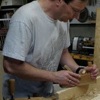I realize this is quite strong for a first post, and hope you will forgive that. I'm mostly a messenger here, with knowledge expressed earlier and better by generations of hand plane experts, and making no claims about any "best" answer.
The recent Fine Woodworking article "Every Handplane Needs a Tuneup" and accompanying video are incomplete (at least) on some critical points, posing a real risk of ruining a good tool. This is particularly true for folks starting with high quality handplanes like Veritas and Lie-Nielsen, which are a) quite unlikely to need several of the recommended procedures, and b) quite likely to be screwed up if you don't know a good deal more than is presented in the article and video.
Here is the original FWW video:
http://www.finewoodworking.com/toolg....aspx?id=35026
And here is a video response, which points out the most serious issues and recommends an alternate tuneup:
http://www.youtube.com/watch?v=pLhQE...ature=youtu.be
There are fairly extensive comments in the description section of the video as well.
No disrespect is intended to the author Tommy MacDonald, who responded quickly and kindly to my concern, or to FWW, both of whom have taught and inspired many woodworkers. Tommy's high end planes apparently needed at least some of this work. On the other hand, I have set up many planes for friends, students, customers, and myself, and while some brands needed everything in the book--or relegation to paperweight--none of the top quality planes needed frog removal, sole flattening, or chip breaker work. After blade prep, honing, and setting the cut, they worked beautifully.
It's a matter of playing the probabilities; doing what's sure to help (super sharp, light shaving) and letting the plane tell you if it needs more. If it does need more, look to a thorough treatment of the subject like Garrett Hack's "The Handplane Book".
I'll be interested to hear the collective Neanderthal wisdom on this subject!




 Reply With Quote
Reply With Quote

 . Double checking the chipbreaker after tapping is smarter too--I was hastening to beat the youtube 10 minute limit, which I had missed more than once--a bit overwhelmed, and you caught me!
. Double checking the chipbreaker after tapping is smarter too--I was hastening to beat the youtube 10 minute limit, which I had missed more than once--a bit overwhelmed, and you caught me!





